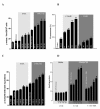Antioxidant rich flavonoids from Oreocnide integrifolia enhance glucose uptake and insulin secretion and protects pancreatic β-cells from streptozotocin insult
- PMID: 22169757
- PMCID: PMC3267669
- DOI: 10.1186/1472-6882-11-126
Antioxidant rich flavonoids from Oreocnide integrifolia enhance glucose uptake and insulin secretion and protects pancreatic β-cells from streptozotocin insult
Abstract
Background: Insulin deficiency is the prime basis of all diabetic manifestations and agents that can bring about insulin secretion would be of pivotal significance for cure of diabetes. To test this hypothesis, we carried out bioactivity guided fractionation of Oreocnide integrifolia (Urticaceae); a folklore plant consumed for ameliorating diabetic symptoms using experimental models.
Methods: We carried out bioassay guided fractionation using RINmF and C2C12 cell line for glucose stimulated insulin secretion (GSIS) and glucose uptake potential of fractions. Further, the bioactive fraction was challenged for its GSIS in cultured mouse islets with basal (4.5 mM) and stimulated (16.7 mM) levels of glucose concentrations. The Flavonoid rich fraction (FRF) was exposed to 2 mM streptozotocin stress and the anti-ROS/RNS potential was evaluated. Additionally, the bioactive fraction was assessed for its antidiabetic and anti-apoptotic property in-vivo using multidose streptozotocin induced diabetes in BALB/c mice.
Results: The results suggested FRF to be the most active fraction as assessed by GSIS in RINm5F cells and its ability for glucose uptake in C2C12 cells. FRF displayed significant potential in terms of increasing intracellular calcium and cAMP levels even in presence of a phosphodiesterase inhibitor, IBMX in cultured pancreatic islets. FRF depicted a dose-dependent reversal of all the cytotoxic manifestations except peroxynitrite and NO formation when subjected in-vitro along with STZ. Further scrutinization of FRF for its in-vivo antidiabetic property demonstrated improved glycemic indices and decreased pancreatic β-cell apoptosis.
Conclusions: Overall, the flavonoid mixture has shown to have significant insulin secretogogue, insulinomimetic and cytoprotective effects and can be evaluated for clinical trials as a therapeutant in the management of diabetic manifestations.
© 2011 Ansarullah et al; licensee BioMed Central Ltd.
Figures






Similar articles
-
Two new compounds from the aerial parts of Bergenia himalaica Boriss and their anti-hyperglycemic effect in streptozotocin-nicotinamide induced diabetic rats.J Ethnopharmacol. 2014 Mar 28;152(3):561-7. doi: 10.1016/j.jep.2014.02.002. Epub 2014 Feb 15. J Ethnopharmacol. 2014. PMID: 24534525
-
Antihyperglycemic, antilipid peroxidation, and insulin secretory activities of Otostegia persica shoot extract in streptozotocin-induced diabetic rats and in vitro C187 pancreatic β-cells.Pharm Biol. 2013 Feb;51(2):253-9. doi: 10.3109/13880209.2012.718351. Epub 2012 Nov 7. Pharm Biol. 2013. PMID: 23134106
-
Flavanols and triterpenoids from Myrianthus arboreus ameliorate hyperglycaemia in streptozotocin-induced diabetic rats possibly via glucose uptake enhancement and α-amylase inhibition.Biomed Pharmacother. 2020 Dec;132:110847. doi: 10.1016/j.biopha.2020.110847. Epub 2020 Oct 14. Biomed Pharmacother. 2020. PMID: 33068933
-
Recent advances in understanding the anti-diabetic actions of dietary flavonoids.J Nutr Biochem. 2013 Nov;24(11):1777-89. doi: 10.1016/j.jnutbio.2013.06.003. Epub 2013 Sep 9. J Nutr Biochem. 2013. PMID: 24029069 Free PMC article. Review.
-
Flavonoids, Isoflavonoids and others Bioactives for Insulin Sensitizations.Curr Diabetes Rev. 2024;20(2):e270423216247. doi: 10.2174/1573399819666230427095200. Curr Diabetes Rev. 2024. PMID: 37102490 Review.
Cited by
-
Anti-diabetic effects of Caulerpa lentillifera: stimulation of insulin secretion in pancreatic β-cells and enhancement of glucose uptake in adipocytes.Asian Pac J Trop Biomed. 2014 Jul;4(7):575-80. doi: 10.12980/APJTB.4.2014APJTB-2014-0091. Asian Pac J Trop Biomed. 2014. PMID: 25183280 Free PMC article.
-
Caenorhabditis elegans as model system in pharmacology and toxicology: effects of flavonoids on redox-sensitive signalling pathways and ageing.ScientificWorldJournal. 2014;2014:920398. doi: 10.1155/2014/920398. Epub 2014 Apr 30. ScientificWorldJournal. 2014. PMID: 24895670 Free PMC article.
-
In vitro cytoprotective activity of cyanidin 3-glucoside extracts from Haematocarpus validus pomace on streptozotocin induced oxidative damage in pancreatic β-cells.Saudi J Biol Sci. 2021 Sep;28(9):5338-5348. doi: 10.1016/j.sjbs.2021.05.065. Epub 2021 May 29. Saudi J Biol Sci. 2021. PMID: 34466113 Free PMC article.
-
In-silico, in-vitro and in-vivo Biological Activities of Flavonoids for the Management of Type 2 Diabetes.Curr Drug Discov Technol. 2024;21(5):e120124225551. doi: 10.2174/0115701638290819231228081120. Curr Drug Discov Technol. 2024. PMID: 38243931 Review.
-
Antimalarial Activity of Fagaropsis angolensis (Rutaceae) Crude Extracts and Solvent Fractions of Its Stem Bark Against Plasmodium berghei in Mice.J Exp Pharmacol. 2021 Jan 5;12:683-693. doi: 10.2147/JEP.S289478. eCollection 2020. J Exp Pharmacol. 2021. PMID: 33447095 Free PMC article.
References
-
- Moller DE, Flier JS. Insulin resistance: mechanisms, syndrome and complications. N Engl J Med. 1991;325(13):939–948. - PubMed
-
- Balkau B, Charles MA, Eschwege E. Discussion épidémiologique des nouveaux critères de diabète = Epidemiological debate about new criterions of diabetes. MTE (Medecine therapeutique endocrinologie) 2000;2:229–234.
-
- Djrolo F, Houngbe H, Avode G, Addra B, Kodjoh N, Avinadje M, Monterio B. Le diabete lie a la mal nutrition: Malnutrition related diabetes. Med Afr Noire. 1998;45(8/9):538–542.
Publication types
MeSH terms
Substances
LinkOut - more resources
Full Text Sources
Medical

